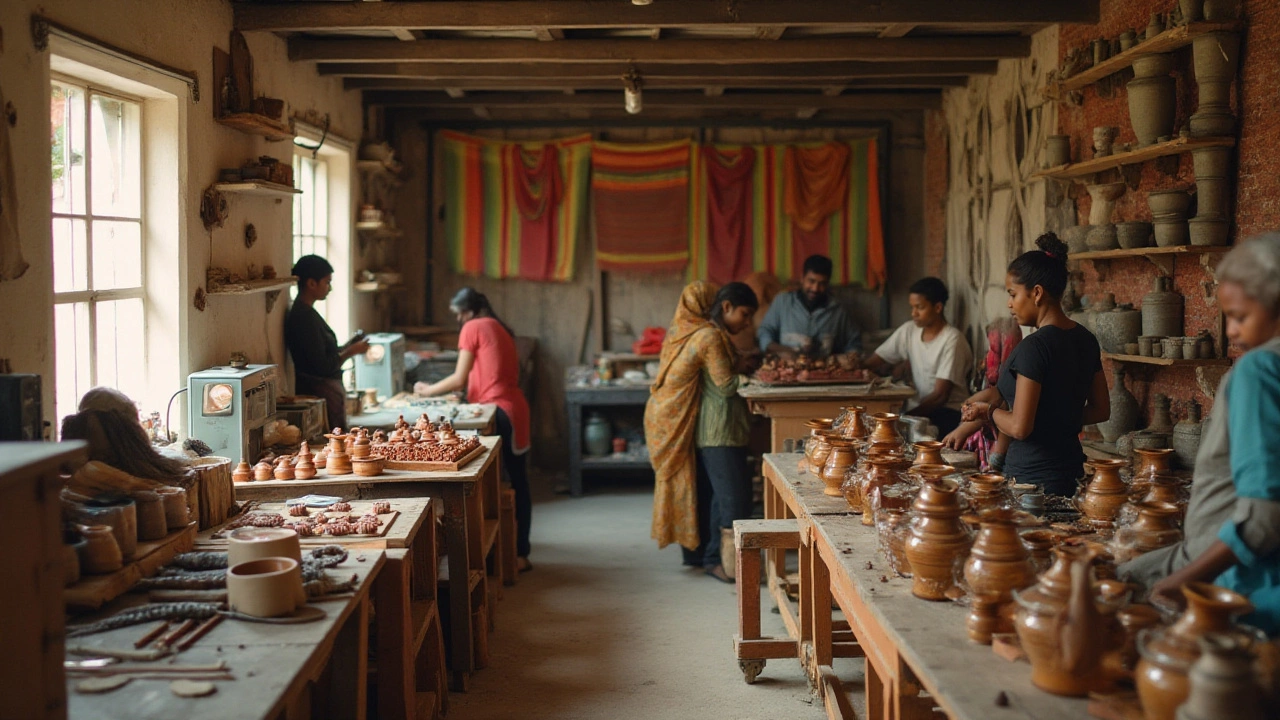 Jan, 16 2025
Jan, 16 2025
In today’s rapidly evolving market, small scale manufacturing has taken center stage as a hotbed of innovation and creativity. These businesses are small, yet mighty, finding their niche by crafting specialized and high-quality products that mass production simply can't replicate. Whether it’s about customizing the latest eco-friendly gadgets or handcrafting artisanal food products that tell a story, small scale manufacturers are catering to a growing consumer craving for personal touch and sustainability.
The appeal doesn’t just stop at creativity; technology is playing a pivotal role in democratizing manufacturing. With tools like 3D printing, advanced software, and Internet of Things (IoT) devices, small enterprises are able to produce goods with precision and efficiency previously only available to large-scale operations. This marriage of skill and technology is ushering in a new era of opportunity for savvy entrepreneurs willing to dive into this dynamic field.
- Current Trends in Small Scale Manufacturing
- Sustainable and Eco-friendly Manufacturing
- Role of Technology in Small Scale Manufacturing
- Opportunities and Challenges for New Entrepreneurs
Current Trends in Small Scale Manufacturing
The landscape of small scale manufacturing is being reshaped by the confluence of technology, sustainability, and changing consumer preferences. The first noticeable trend is the increasing demand for locally sourced, sustainable products. As the world becomes more environmentally conscious, consumers are seeking products that not only meet their needs but also do so in a way that minimizes environmental impact. This has led many manufacturers to adopt eco-friendly practices, such as using recycled materials or opting for renewable energy sources in production. Crafting goods with a minimal carbon footprint while maintaining high quality is not just a trend, but a necessity.
Another significant trend is the rise of digital tools that are revolutionizing the manufacturing process. Technologies such as 3D printing provide the means for rapid prototyping and customization, allowing manufacturers to produce precisely tailored items in small batches. This trend towards customization is empowering businesses to offer unique products that stand out in an increasingly saturated market. Additionally, digital solutions like cloud-based design software make managing production details more accessible and efficient, even for those operating on a shoestring budget. The democratization of technology means anyone with a creative idea can bring it to life with fewer barriers.
Moreover, there's a growing trend of collaboration and community-based production. Small manufacturers are forming networks, sharing resources, and sometimes even merging efforts to tackle larger projects or tap into wider markets. Platforms like "MakerSpaces" and local crafting communities provide the necessary infrastructure and knowledge base for individuals and startups looking to enter the manufacturing space. These communities foster innovation by allowing members to exchange skills, ideas, and tools. It's a structure that benefits all parties involved and can result in unexpected synergies and products.
In addition to these trends, many small manufacturers are focusing on heritage and artisan techniques, tapping into the nostalgia factor that resonates with many consumers. Handmade products offer a personal touch and a sense of authenticity that mass-produced items often lack. This trend reflects a broader consumer shift towards valuing quality and craftsmanship over quantity. Some entrepreneurs are even reviving traditional methods with a modern twist to fit contemporary aesthetic and functional needs. This blend of old and new appeals to those who appreciate storied products that last through generations.
"The revival of craftsmanship is more than a trend; it represents a deep societal shift towards valuing quality, meaning, and heritage," says renowned industry analyst John Seward.

Sustainable and Eco-friendly Manufacturing
In an age where climate change and environmental responsibility are at the forefront of global consciousness, sustainable and eco-friendly manufacturing has moved from a niche interest to a mainstream expectation. This transformation is fueled by both consumer demand and a growing awareness of our collective impact on the planet. Entrepreneurs within the small scale manufacturing industry have been quick to adapt, finding innovative ways to minimize waste, employ renewable resources, and craft products that lessen their carbon footprint. Many small workshops are embracing clean technologies and sustainable supplies, thus setting themselves apart from traditional manufacturing giants.
One notable shift is the increased use of recycled materials. Manufacturers are now sourcing materials that would otherwise end up in landfills—such as reclaimed wood, recycled plastics, and upcycled fabrics—and turning them into coveted goods. This not only aids in waste reduction but also attracts a demographic of environmentally conscious consumers eager to support green businesses. A rise in the adoption of biodegradable packaging further exemplifies this commitment to ecology, as more companies opt for solutions that won’t harm the earth in their disposal.
Innovation through Technology
Technology is another driving force in making small scale manufacturing more eco-friendly. The integration of energy-efficient machinery and renewable energy sources like solar or wind power into manufacturing processes is gaining traction. The use of digital inventory systems helps manage resources smartly, ensuring that materials are used as effectively as possible and reducing unnecessary waste.
‘The Sustainable Development Goals are the blueprint to achieve a better and more sustainable future for all,’ as emphasized by a UN report. This perspective is at the core of many small manufacturers' missions, as they aim to align their business practices with these international goals.
Challenges and Success Stories
While the move towards sustainable practices is commendable, it does come with its own set of challenges. Frequently, eco-friendly materials and processes can be more costly than traditional options, posing financial constraints, especially for startups. Yet, many small businesses have found solutions through collaboration and innovation. Groups of manufacturers often band together to buy materials in bulk, decreasing individual costs and fostering a spirit of community. There's also a growing support network of investors eager to back green initiatives, providing much-needed financial backing to push these eco-conscious projects forward. Stories of success abound, with many small enterprises thriving not just because of their commitment to the planet, but because they have tapped into a lucrative market eager for their goods.
As environmental concerns continue to shape consumer behavior and governmental policies, sustainable and eco-friendly manufacturing is not just a trend—it's the future. By continuing to innovate and adapt, small scale manufacturers are not only carving a niche for themselves but are also paving the way for a more sustainable and responsible industry landscape. The demand for products that are kind to the earth is not waning, and those businesses that answer this call with quality, innovation, and integrity are likely to emerge as future leaders in the marketplace.

Role of Technology in Small Scale Manufacturing
Technology is the lifeline that is breathing new energy and possibility into the realm of small scale manufacturing. As we step further into this digital age, more and more small manufacturers are harnessing the power of advanced technology to streamline their operations, increase efficiency, and produce goods with a level of customization that was once unimaginable. At the forefront of this technological revolution is the use of 3D printing. This incredible technology allows small manufacturers to produce prototypes and final products quickly, reducing both time and resources spent. With 3D printers becoming more affordable, they're no longer just the domain of large companies; even the smallest enterprises can take advantage.
Beyond 3D printing, digital technology tools such as Computer-Aided Design (CAD) software provide businesses with the ability to design intricate products with precision. CAD tools have democratized design processes, offering a playground for innovation and opening up new avenues for creativity and experimentation. Coupled with the connectivity brought by the Internet of Things (IoT), manufacturers can now monitor production lines in real-time, ensure quality control, and optimize resource usage. An efficient production line, coupled with technology, can significantly reduce waste, aligning with the emerging trend towards sustainability.
Moreover, advancements in AI and machine learning are making it possible to predict consumer needs and market trends with astonishing accuracy. By analyzing huge volumes of data, even small manufacturers can gain insights to forecast demand and plan production schedules accordingly. This predictive capability minimizes storage costs and avoids excess inventory, a boon for businesses working with limited space and budgets. These advanced technologies level the playing field, allowing small manufacturers to compete effectively against larger organizations. In many ways, this tech integration empowers small, agile businesses to pivot and respond to market needs with speed big companies could struggle to match.
To illustrate, consider how a family-run furniture business used AI to identify top design trends. By implementing machine learning tools, they tailored their products based on consumer preferences and even implemented augmented reality (AR) to let customers visualize products in their homes before purchase. According to a report by Statista, 64% of businesses using AI noticed significant improvement in customer satisfaction, a testament to the power of these tools.
"Technology will not replace great manufactory workers, but workers who are adept at working with technology will replace those who are not," observed Andrew McAfee, cofounder of the MIT Initiative on the Digital Economy.
In essence, embracing technology in small scale manufacturing isn't just an option; it's crucial for survival and growth. As these small entities continue to leverage cutting-edge technology, they are becoming robust, resilient, and more importantly, revolutionary in how they redefine and adapt the manufacturing landscape. For aspiring entrepreneurs and existing small business owners, the integration of technology presents incredible opportunities to innovate and remain competitive in the increasingly tech-driven global market.

Opportunities and Challenges for New Entrepreneurs
Entering the world of small scale manufacturing presents a myriad of opportunities for entrepreneurs eager to make their mark. With the demand for locally made, personalized, and environmentally conscious products soaring, new ventures can tap into niches previously untapped by larger corporations. This market allows for creativity in product development, from bespoke home goods to specialty foods that cater to the conscious consumer. Capitalizing on this demand can turn passionate side projects into lucrative businesses with a dedicated customer base.
Yet with every opportunity comes its challenges. One of the significant hurdles for aspiring entrepreneurs is securing sufficient funding to kickstart their ventures. Small scale manufacturers often require initial capital to purchase equipment, raw materials, and manage overhead costs. Traditional financing options might not always be feasible, necessitating innovative approaches like crowdfunding or building community investment networks to gather support. Moreover, managing supply chains efficiently is vital, as sourcing sustainable and high-quality inputs can be both costly and logistically complex.
Technology is a double-edged sword in this realm. While advances like 3D printing and digital modeling can significantly lower production costs and enable customization, keeping up with tech trends necessitates continuous learning and adaptation. For those lacking tech-savviness, it might be wise to collaborate with partners or hire staff with the requisite expertise. Navigating the digital landscape also requires developing an online presence to reach a broader audience. Crafting a compelling narrative around your brand and products is essential in a saturated digital market.
"The first step towards achieving your dreams is having the right mentor," noted Joel Brown, a respected entrepreneur in the digital space. He emphasized the importance of guidance in avoiding common pitfalls and costly mistakes.
To tackle the complexities and enjoy the fruits of the hottest business of today, it's crucial to build a sturdy network of mentors and fellow entrepreneurs. Tapping into entrepreneurial communities can provide insights and access to resources that might otherwise remain elusive. Engaging with industry events, workshops, and forums is also beneficial in fostering valuable connections with potential trade partners and thought leaders.
Lastly, understanding the evolving consumer trends and adapting swiftly is critical. Staying attuned to market demands and feedback allows for fine-tuning products and strategies effectively. Despite the hurdles, the satisfaction from seeing an idea blossom into a recognized brand makes the journey worthwhile. New entrepreneurs should embrace this fertile ground of manufacturing opportunities and navigate the challenges with resilience and innovation.